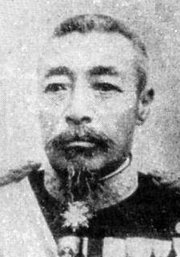- Oku Yasukata
-
Count Oku Yasukata
Japanese General Count Oku YasukataBorn January 5, 1847
Kokura, Buzen Province, JapanDied July 19, 1930 (aged 83)
Tokyo, JapanAllegiance Empire of Japan Service/branch  Imperial Japanese Army
Imperial Japanese ArmyYears of service 1871 - 1911 Rank Field Marshal Commands held IJA 5th Division, IJA 1st Army, Imperial Guard of Japan, IJA 2nd Army Battles/wars Boshin War
Taiwan Expedition of 1874
Satsuma Rebellion
First Sino-Japanese War
Russo-Japanese WarAwards Order of the Golden Kite (1st class) In this Japanese name, the family name is "Oku".Count Oku Yasukata (奥 保鞏, 5 January 1847 – 19 July 1930) was a Japanese field marshal and leading figure in the early Imperial Japanese Army.
Contents
Biography
Early life
Born in Kokura (now in present-day Kitakyūshū) to a samurai family of the Kokura domain in Buzen Province, Oku joined the military forces of the nearby Chōshū Domain during the Boshin War in their struggle to overthrow the Tokugawa Shogunate and bring about the Meiji Restoration.[1]
Military career
Appointed a commander of the new Imperial Japanese Army, Oku fought against the disgruntled samurai insurgents during the Saga Rebellion of 1871. He was later a survivor of the Taiwan Expedition of 1874. During the Satsuma Rebellion, he defended Kumamoto Castle during its siege as commander of the 13th Infantry Regiment.
During the First Sino-Japanese War Oku succeeded General Nozu Michitsura commander of the IJA Fifth Division of the IJA First Army. Later, he successively held posts as commander of the Imperial Guards and Governor-general for the defense of Tokyo. He was elevated to the title of danshaku (baron) under the kazoku peerage system in 1895, and was promoted to army general in 1903.[2]
During the Russo-Japanese War, Oku went to the front as commanding general of the IJA 2nd Army and was noted for his role in the Battle of Nanshan, Battle of Shaho, Battle of Mukden, and other campaigns.[3]
Oku was awarded the Order of the Golden Kite (1st class) in 1906, and elevated from baron to hakushaku (count) in 1907. In 1911, he received the largely honorary rank of Field Marshal.[4]
Oku refused to attend strategy and staff meetings, and thereby gained a reputation for being both a “lone wolf” and also a brilliant tactician capable of independent action. However, in fact, Oku's reluctance to attend the staff meetings was due to his partial deafness, and inability to comprehend and contribute to the discussions.[5]
Post-war life
Oku had absolutely no interest in politics, and lived in virtual seclusion after the war. When he died in 1930, many people were astonished, thinking that he had died years previously.[5]
References
Books
- Craig, Albert M. Chōshū in the Meiji Restoration. Cambridge: Harvard University Press, 1961.
- Dupuy, Trevor N. (1992). Encyclopedia of Military Biography. I B Tauris & Co Ltd. ISBN 1-85043-569-3.
- Harries, Meirion (1994). Soldiers of the Sun: The Rise and Fall of the Imperial Japanese Army. Random House. ISBN 0-679-75303-6.
- Keane, Donald (2005). Emperor Of Japan: Meiji And His World, 1852-1912. Columbia University Press. ISBN 0-231-12341-8.
- Paine, S.C.M. (2003). Sino-Japanese War of 1894-1895: Perception, Power, and Primacy. Cambridge University Press.
- Jukes, Geoffry (2002). The Russo-Japanese War 1904-1905. Osprey Essential Histories. ISBN 9-78184-17644-67.
External links
- National Diet Library. "Oku Yasukata". Portraits of Modern Historical Figures. http://www.ndl.go.jp/portrait/e/datas/44.html.
Notes
Categories:- Marshals of Japan
- 1847 births
- 1930 deaths
- People from Kitakyūshū
- People of the Boshin War
- Kazoku
- People of the First Sino-Japanese War
- Japanese military personnel of the Russo-Japanese War
- Japanese generals
- People in Meiji period Japan
- Recipients of the Order of the Golden Kite
- Recipients of the Virtuti Militari
Wikimedia Foundation. 2010.

